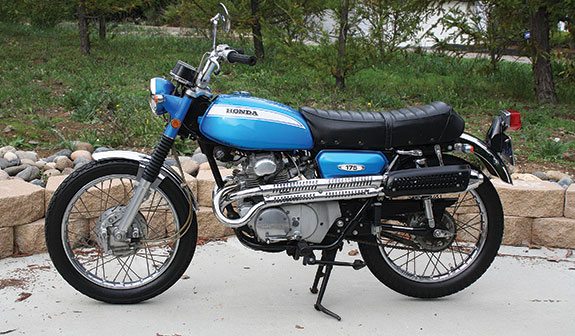
There certainly were lots of variations of Honda’s 175 twin over its six years on the market, from Super Sport to Motosport, with the Scrambler sitting right in the middle. All part of Honda’s marketing wisdom—offering roughly the same bike in a variety of styles, appealing to any number of potential buyers.
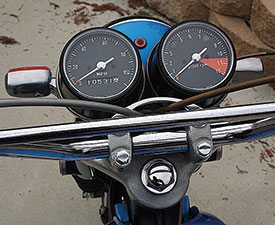
In the mid-1960s Americans were falling in lust with smaller, lightweight Japanese motorcycles that were cheap and dependable. And while our nation’s motorcyclists were divided between four-strokers and two-strokers, cubic capacity was always a good sales tool. Give a bike a bigger number, do some serious advertising and see who comes into the showroom.
The predecessor to the 175 was Honda’s 160 twin, with a bore of 50mm, stroke, 41mm, for a displacement of 161cc. Merely boring each cylinder out by 2mm allowed the ad people to advertise this 174cc engine as a 175. The bean counters liked this inexpensive way of doing things. The rather oversquare 175 engine kept the 160’s two valves per cylinder, which were operated by a chain-driven single overhead camshaft, a one-piece design running in well-lubricated bores machined into the aluminum head. The 175 also used the 160’s two 20mm Keihin carbs. Compression ratio was upped half a point from 8.5:1 to 9:1, and that was about it.
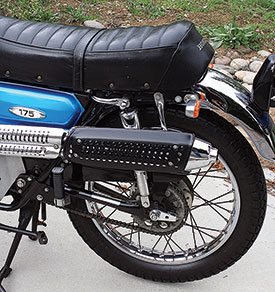
However, the claimed horsepower went from 16.5 to 19.7 at 10,000 rpm; a 20 percent increase in horsepower for a mere 13cc is considerable. That was also in the days before motorcycle magazines had easy access to dynamometers, and often relied on factory claims.
The bigger CL kept on with the 160’s 360-degree crankshaft, which ran on four main bearings, one a ball bearing and three rollers. Very dependable. It also used the CL160’s starting system—by kick. Only a few people seemed to miss having a button. Kicking over a 175 twin did not require much effort, and it asserted a certain manliness…which was the point of the Scrambler design. The upswept pipes with covers to protect the left leg of both rider and passenger were a successful styling notion. As a matter of fact, when sales of the low-piped, street-going CB160 lagged, leaving bikes on the showroom floor, Honda started selling CL “dealer kits” that could turn a CB into a CL.
Definitely new was the 5-speed gearbox, which the CL’s roadster CB sibling did not get until a year or so later. This gave the CL more of a dual-purpose range, as the extra cog allowed for lower gearing for the dirt roads, higher for the highways. The gearbox developers had been busy, as Honda had been a bit upset when Suzuki put six gears in its 1965 250cc X6 Hustler.
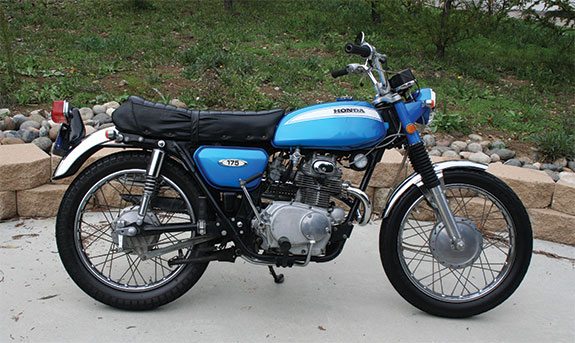
The chassis was typical late-1960s Honda, with the engine/transmission unit being a structural member, the top of the engine suspended from the tubular backbone, and the cylinders leaning forward about 30 degrees. It had a hydraulically damped telescoping fork, a pair of DeCarbon shocks at the back, 18-inch wheels, drum brakes and a 50-inch wheelbase. No tachometer, only a speedo built into the headlight nacelle, just like the 160. And a non-threatening 31-inch seat height. Ground clearance was almost eight inches, and a big skid plate protected the sump. Price was a miserly $645, a mere $35 more than the previous CL160.
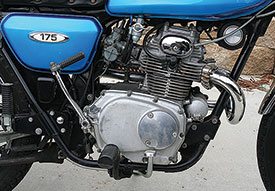
Honda obviously felt that the 175 numerology might get rid of the relatively unsuccessful 160 and began rather hastily bolting the bored-out engine into the previous chassis. But Soichiro Honda’s boys in the Skunk Works had more plans for this model. In the second year the CL175K3 appeared, mysteriously skipping K1 and K2. Major changes had been made to the frame—it became a semi-full-cradle, the semi aspect being the single downtube from the steering head, splitting into two tubes running under the engine. And the engine was virtually vertical.
Along with the new frame, Honda jettisoned the old nacelle idea and had individual instruments up above the headlight, adding a tachometer. This way the rider could see when he was hitting 10,000 rpm and nearly 20 horsepower were working hard at spinning the rear wheel. Even with a couple of ponies being lost between the crankshaft and the rear axle, that was a lot of giddy up for a bike weighing in at 275 pounds wet. With the gas tank filled up with 2.4 gallons of petroleum by-product, the bike could travel 150 miles.
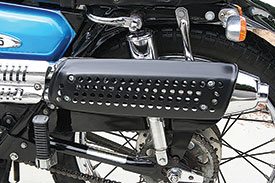
Honda also saw that the young and relatively impecunious crowd considered the “scrambler” design cool, but that this was truly a street bike, with minor pretentions at any capability in seriously rough terrain. OK, so give it an electric starter.
Then the Skunk Works unveiled the new SL175 Motosport, which appeared for the 1970 model year. This had a whole new frame, a full double-cradle, extending the wheelbase another inch and a half, longer suspension travel and more torque at lower rpm. Also, a solo saddle, so no room for the co-ed.
The CL street scrambler soldiered on through 1973, price going up to a mildly inflationary $715. Then the engine got bored out another 3.5mm, now seriously oversquare, raising the ante to 198cc and called, quite naturally, the CL200. And the price of the 1974 200 went up over $200, to $935—serious inflation.
After 1975 Honda dropped the Scrambler designation; the XL singles were taking over.

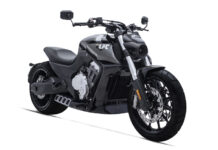
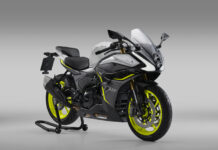
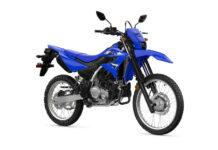
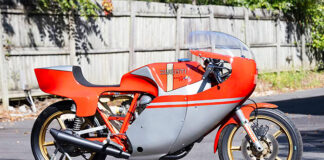
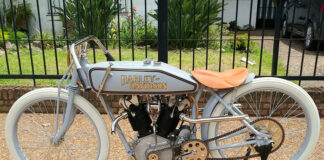
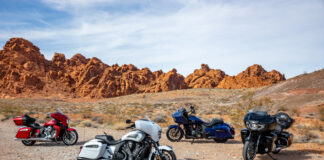

I bought one of these CL175’s new in the early 1970’s, not sure of what year it was. I was living in Greeley, CO and put many miles on it commuting to work and traveling north to Cheyenne, south to Denver or west to Estes Park through the mountains. It was my first motorcycle purchased new and was one of the gold metal-flake colored ones.
I have a 1973 CL175. For a small bike it is fairly comfortable for my 34 inch inseam. The power adequate to get out of its own way. The fun of this bike is its simplicity. Kick start when you want. Drum brakes work decently on such a light bike. Good gas mileage. Carb and points. When you wring it up to 9 grand, it just plain speaks to you, even though you’d be hard pressed to get up to 60 mph comfortably. Really can’t get into trouble on the bike unless you’re trying to keep up with some faster traffic. A great bike for little traveled curvy two lane roads. The closest “modern” bike to this one, I think, is the Yamaha TW200: small, light, makes you grin every time you ride, simple, feel like a hero with every move even though you’re really not heading anywhere in particular. Hmmm, I think THIS will be my next bike when the Scrambler needs a passin’ on to the next curator.
I bought a new CL175 new in ’73 and over the next six years put over 35,000 miles on it. bulletproof reliability. I still miss it!
Hi, I’ve just got one today 8000 mls 1969 looks great, hope it is ok, I’ve just sold my Suzuki Hyabussa, I wander if it will keep up lol. Regards Peter UK
Hi, I’ve just got one today 8000 mls 1969 looks great, hope it is ok, I’ve just sold my Suzuki Hyabussa, I wander if it will keep up lol. Regards Peter UK
I want one. Anyone know where i can buy one? Only want one that’s in perfect condition.
Hey here’s one for sale in Corona Del Mar Ca 949-673-0696
I have a 1971 175 honda and it was my mother-in-law and I’m looking for parts to restore it. Point me in the right direction ro find them. Please and thank you
I have 1972 in mint condition it has less than 3000 miles on it.
This is an old post not sure if you are still around or still looking. I have just finished up a 1973 CB175 using some pretty cool aftermarket parts from motogadget for the complete rewire. All new LED lights, tires, bearings, seals, bushings, etc. getting close to 8000 original miles. I have lots of details on this bike. I will put it on Bringatrailer.com after this winter with a $3000 resrve, but would sell it outright for $3500. I’m not a motorcycle guy, I just like projects and this project is done. I always sell my projects for the $$ I have in them unless I put them in auction. Shipping is usually $500 to $800 for a motorcycle.
Just bought a 1970 CL 175 with 5500 miles and one owner from new. I love it already.
Looking to buy 1970 Honda CL175K3 ?
Randy, I have a friend that has one…..Not running and needs a lot of work…if you’re interested….He forwarded some pictures to me if you are interested.
All, I have a friend that has a CL175K3…..Not running and needs a lot of work…if you’re interested….He forwarded some pictures to me I can share, if you are interested.
Thanks
I am looking for an engine for my 1970 CL 175 scrambler. Any takers?
I have a 1970 cl175 scrambler twin complete looks fairly decent after I scrubbed the 30 years of barn dust off it. Anyone interested let me know. 319-252-2356 in Iowa
Have a ’68-’69 CL 175 KOScrambler that’s been in the barn for 20 years after it was given to me by the original owner. Needs…lotsaTLC. $800.
New tires, kickstart, 16,453 miles, need to say it’s a classic!
I need to buy this sounds like great project i have 1971 gold scrambler email me if have still or are near Tennessee @jwebber2012@dbzmail.com
I have a 1969 cl175 scrambler with 755 miles all original. I wonder what that is worth.
I had a Honda 175 that I thought was designated as a CL175. It had a high side pipe, high fenders, and was painted in candy sapphire blue. I really enjoyed that bike and learned to ride it well. It was stolen from me in early 1971. I wish I could find a photo of one.
Had a CL 175 bought new in 1975; it was my ride for 2 years of High School and trail riding in the Black Hills. My beef with it was overweight for displacement but it got the job done.
What type of oil do you guys use in these vintage bikes? I have a 1969 CL175 Scrambler. Calls for SAE 30, I presume motorcycle oil.